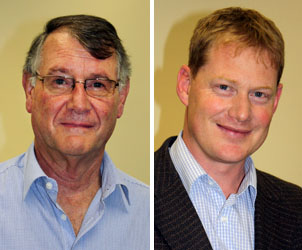Higher than expected prevalence of dementia in South African urban black population
 |
| Prof. Malan Heyns and Mr Rikus van der Poel |
Pilot research done by University of the Free State (UFS) indicates that the prevalence of dementia, of which Alzheimer’s disease is only one of the causes, is considerably higher than initially estimated. Clinical tests are now underway to confirm these preliminary findings.
To date it has been incorrectly assumed that dementia is less prevalent among urban black communities. This assumption is strongly disputed by the findings of the current study, which indicates a preliminary prevalence rate of approximately 6% for adults aged 65 years and older in this population group. Previous estimates for Southern Africa have been set at around 2,1%.
The research by the Unit for Professional Training and Services in the Behavioural Sciences (UNIBS) at the UFS and Alzheimer’s South Africa is part of the International 10/66 Dementia Research Group’s (10/66 DRG) initiative to establish the prevalence of dementia worldwide.
Mr Rikus van der Poel, coordinator of the local study, and Prof. Malan Heyns, Principal Investigator, say worldwide 66% of people with dementia live in low and middle income countries. It is expected that it will rise to more than 70% by 2040, and the socio-economic impact of dementia will increase accordingly within this period. 21 September marks World Alzheimer’s Day, and this year the focus is on the global economic impact of dementia. Currently, the world wide cost of dementia exceeds 1% of the total global GDP. If the global cost associated with dementia care was a company, it would be larger than Exxon-Mobil or Wal-Mart.
The researchers also say that of great concern is the fact that South Africa’s public healthcare system is essentially geared toward addressing primary healthcare needs, such as HIV/Aids and tuberculosis. The adult prevalence rate of HIV was 18,1% in 2007. According to UNAIDS figures more than 5,7 million people in South Africa are living with HIV/Aids, with an estimated annual mortality of 300 000. In many instances the deceased are young parents, with the result that the burden of childcare falls back on the elderly, and in many cases elderly grandparents suffering from dementia are left without children to take care of them. “These are but a few reasons that highlight the need for advocacy and awareness regarding dementia and care giving in a growing and increasingly urbanized population,” they say.
Low and middle income countries often lack epidemiological data to provide representative estimates of the regional prevalence of dementia. In general, epidemiological studies are challenging and expensive, especially in multi-cultural environments where the application of research protocols relies heavily on accurate language translations and successfully negotiated community access. Despite these challenges, the local researchers are keen to support advocacy and have joined the international effort to establish the prevalence of dementia through the 10/66 DRG.
The 10/66 DRG is a collective of researchers carrying out population-based research into dementia, non-communicable diseases and ageing in low and middle income countries. 10/66 refers to the two-thirds (66%) of people with dementia living in low and middle income countries, and the 10% or less of population-based research that has been carried out in those regions.
Since its inception in 1998, the 10/66 DRG has conducted population based surveys in 14 catchment areas in ten low and middle income countries, with a specific focus on the prevalence and impact of dementia. South Africa is one of seven LAMICs (low and medium income countries) where new studies have been conducted recently, the others being Puerto Rico, Peru, Mexico, Argentina, China and India.
Mr Van der Poel says participating researchers endeavour to conduct cross-sectional, comprehensive, one-phase surveys of all residents aged 65 and older within a geographically defined area. All centres share the same core minimum dataset with cross-culturally validated assessments (dementia diagnosis and subtypes, mental disorders, physical health, anthropometry, demographics, extensive non-communicable risk factor questionnaires, disability/functioning, health service utilization and caregiver strain).
The local pilot study, funded by Alzheimer’s South Africa, was rolled out through an existing community partnership, the Mangaung University of the Free State Community Partnership Programme (MUCPP).
According to Mr Van der Poel and Prof. Heyns, valuable insights have been gained into the myriad factors at play in establishing an epidemiological research project. The local community has responded positively and the pilot phase in and of itself has managed to promote awareness of the condition. The study has also managed to identify traditional and culture-specific views of dementia and dementia care. In addition, existing community-based networks are being strengthened, since part of the protocol will include the training and development of family caregivers within the local community in Mangaung.
“Like most developing economies, the South African population will experience continued urbanization during the next two decades, along with increased life expectancy. Community-based and residential care facilities for dementia are few and far between and government spending will in all probability continue to address the high demands associated with primary healthcare needs. These are only some of the reasons why epidemiological and related research is an important tool for assisting lobbyists, advocates and policymakers in promoting better care for those affected by dementia.”
Media Release
Issued by: Mangaliso Radebe
Assistant Director: Media Liaison
Tel: 051 401 2828
Cell: 078 460 3320
E-mail: radebemt@ufs.ac.za
21 September 2010